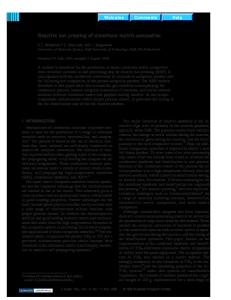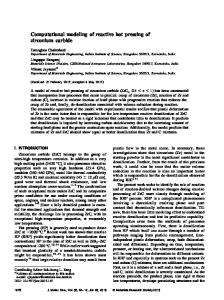Reactive sintering and reactive hot
- PDF / 2,931,227 Bytes
- 8 Pages / 597 x 774 pts Page_size
- 107 Downloads / 364 Views
I.
INTRODUCTION
THE aluminide intermetallic NbA13 is one of three niobium aluminide compounds shown in the Nb-A1 phase diagram in Figure 1.[q NbAI3 has been investigated as a potential high-temperature structural material, particularly because of its low density, 4.54 g/cm 3, high melting temperature, 1680 ~ high aluminum content for oxidation resistance, and ordered D022 crystal structure for creep resistance. However, the ability to obtain physical and mechanical property data has been hindered by processing difficulties. NbAI3 has been produced by arccasting, which results in large-grained, cracked, and inhomogeneous material, or by hot pressing of prealloyed powders, which requires high processing temperatures and pressures and produces porous material, t2-6j Reported mechanical properties from these specimens are inconsistent, probably due to variations in material quality. The goal of the current research was to use reactive synthesis to form high-density NbA13 compacts which could be used for oxidation and mechanical property testing. Reactive sintering (RS) is a controllable powder processing method which is used to produce an ordered compound from elemental constituent powders. It has the benefit of using relatively inexpensive and readily available starting materials. In addition, it has the potential for significant cost savings through energy efficiency. Once initiated, the sintering process is sustained by the heat of formation of the compound which is released during the reaction. Powder metallurgy is also advantageous because it provides the flexibility to form composites. Reactive sintering of aluminides from elemental powders is similar to liquid-phase sintering, except an exothermic synthesis reaction occurs between molten aluminum and the solid phase. During classical liquidphase sintering, a liquid forms as the powder compact J.C. MURRAY, Materials Engineer, is with the Engineering Materials Technologies Laboratories, GE Aircraft Engines, Evendale, OH 45215. R.M. GERMAN, Brush Chair in Materials, is with the Engineering Science and Mechanics Department, Pennsylvania State University, University Park, PA 16802. This article is based on a presentation made in the symposium "Reaction Synthesis of Materials" presented during the TMS Annual Meeting, New Orleans, LA, February 17-21, 1991, under the auspices of the TMS Powder Metallurgy Committee. METALLURGICAL TRANSACTIONS A
is heated above the solidus of one component. If the liquid wets the solid particles, then the structdre densities by capillary action.[7~ During RS of niobium aluminides, molten aluminum reacts with solid niobium particles to form an intermetallic compound. Heat liberated by the formation of the compound sustains the reaction until all of the starting components are consumed by the reaction. Sims et al.[S~ first demonstrated RS of Ni3AI to full density in 1987. In this work, they noted the importance of initial raw materials and processing conditions on the quality of the product. The current article describes a similar study
Data Loading...











